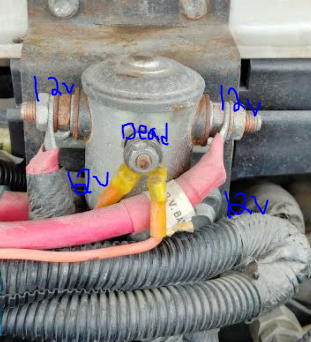TWSchroeder
Active member
- Joined
- Feb 24, 2016
- Posts
- 32
I have enclosed a picture of what I understand to be a battery solenoid. I thought it worked by allowing my cab battery to charge the RV battery only when the ignition key is on. But I might be misunderstanding the function and that is the purpose of my post, since the solenoid (I don't think) is operating as I thought it should. At any rate, I am not sure how to test that it is given what I have observed.
As the pictures show, there are 4 places where I have 12v at the location of the solenoid. This is true when the ignition is ON AND when the ignition is OFF. The key ignition does NOT effect the 12v in anyway.
The pole marked "Dead" is also always dead, whether or not I have the ignition ON or OFF.
It was my understanding/expectation, that when the ignition was one, the pole marked "Dead" would show 12v and the solenoid would switch to ON. However, I am not sure what test I should do to distinguish the solenoid being ON from it being OFF.
I am afraid that the pole marked "Dead" is supposed to be live when the ignition is on, and I assume that to be an INPUT of 12v, not an OUTPUT. If that is the case, then my 12v from the ignition is the problem. Perhaps my only problem. Does that mean that my "only" worry is that I am either never charging the RV battery, OR, I always have them linked such that a dead RV a battery will drain the cab battery.
Thank you for any help in understanding how this functions and how I can test it.
As the pictures show, there are 4 places where I have 12v at the location of the solenoid. This is true when the ignition is ON AND when the ignition is OFF. The key ignition does NOT effect the 12v in anyway.
The pole marked "Dead" is also always dead, whether or not I have the ignition ON or OFF.
It was my understanding/expectation, that when the ignition was one, the pole marked "Dead" would show 12v and the solenoid would switch to ON. However, I am not sure what test I should do to distinguish the solenoid being ON from it being OFF.
I am afraid that the pole marked "Dead" is supposed to be live when the ignition is on, and I assume that to be an INPUT of 12v, not an OUTPUT. If that is the case, then my 12v from the ignition is the problem. Perhaps my only problem. Does that mean that my "only" worry is that I am either never charging the RV battery, OR, I always have them linked such that a dead RV a battery will drain the cab battery.
Thank you for any help in understanding how this functions and how I can test it.


